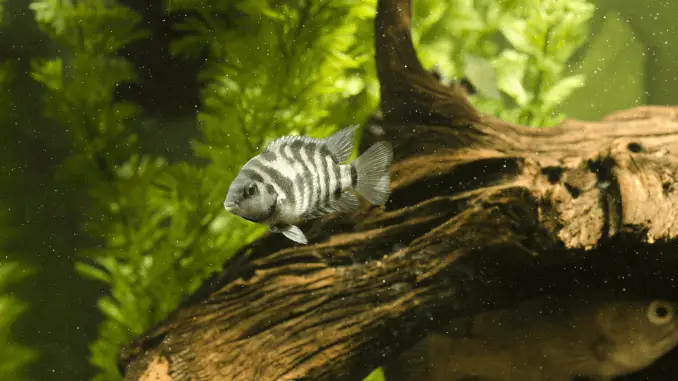
The black convict cichlid, also known as the zebra cichlid, is one of the most popular members of the cichlid family.
It is an incredibly hardy fish, which is easy to care for, making it ideal for beginner fish keepers.
The convict cichlid gets its name from the vertical black and white stripes on its body.
In this article, we will talk through all you need to know about keeping them including dietary needs, ideal tank mates, tank setup, pink and white color varieties, how to control its aggression, and much more.
TABLE OF CONTENTS
Convict Cichlid Facts & Overview
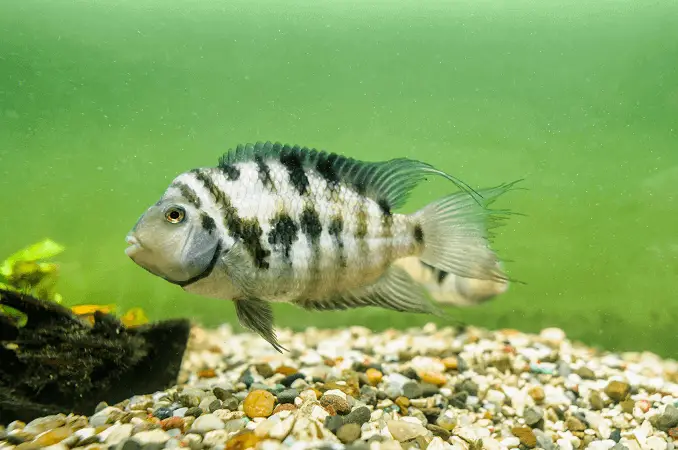
| Category | Rating |
| Care Level: | Moderate |
| Temperament: | Aggressive |
| Color: | Black, white |
| Lifespan: | Over 8 years |
| Size: | Up to 6 inches |
| Diet: | Omnivore |
| Family: | Cichlidae |
| Minimum Tank Size: | 30 gallons |
| Tank Setup: | Freshwater: driftwood and caves |
| Compatibility: | Limited: aggressive |
The black convict cichlid (Archocentrus nigrofasciatus), also known as the zebra cichlid, is a freshwater fish native to the warm rivers of South America.
It will mostly be found in larger streams and rivers, sheltering itself near rocks and sunken branches.
The convict cichlid is one of the most popular members of the Cichlidae family behind oscars and angelfish. Their popularity in the fishkeeping world is due to their hardiness, low care needs, and vibrant coloring. It also makes an outstanding beginner breeder fish due to their receptiveness to mate.
Males will grow up to 6 inches long and females to 4.5 inches. They are a small fish that don’t require much tank space; the minimum recommended size is 30 gallons.
Generally for beginners, they should only be placed in a tank with other convicts due to their aggressive and territorial nature.
Typical Behavior
The convict cichlid is an active fish that is known for its aggressive and territorial behavior. This behavior is common amongst many cichlids.
If a fish encroaches on its territory, it will defend itself by chasing and harassing the other fish.
They will spend most of their time near their territory inside caves and plant matter.
As prolific breeders, they make fantastic parents; therefore their parenting ability is another common behavior you will see. They are attentive parents and you will see them nurturing their fry.
Are Convict Cichlid Fish Aggressive?
Yes, like other members of the Cichlidae family, they are aggressive and extremely territorial.
Appearance
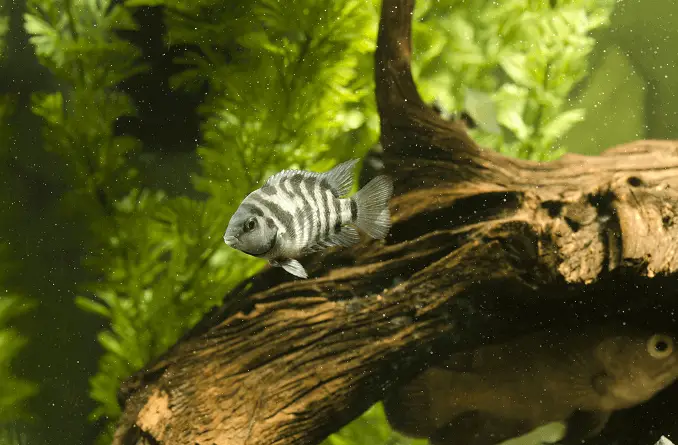
Convict cichlids get their name from their appearance of white and black stripes. They are also referred to as the zebra cichlid.
As adults, they will have 8/9 black stripes across the length of their gray bodies. The males will have larger anal and dorsal fins, whilst females will be smaller with more coloration.
Whilst the majority of them are black, due to selective breeding you can now find, pink, white and gold varieties. Pink ones are increasingly common and have a pink/yellow body with no vertical stripes.
Interestingly all Convict Cichlids are monomorphic so you’ll need to wait until they are sexually matured to tell the difference between males and females (more on this later).
Whilst many members of the Cichlidae family are large fish, the Convict is the runt of the family, with males growing to 6 inches and females to 4.5 inches.
How Big Do Convict Cichlid Fish Get?
The male Convict Cichlid can grow up to 6 inches, whilst the female will grow to around 4.5 inches.
How Do You Tell If A Convict Cichlid Is Male Or Female?
Telling the difference between a male and female Convict is very straight forward.
Males will be longer and generally have larger dorsal and anal fins.
Unusually for fish, the females will have a brighter coloration, with yellow/red spots on their belly once they are sexually mature. She will also have more vivid black strips than her male counterpart.
Habitat and Tank Requirements
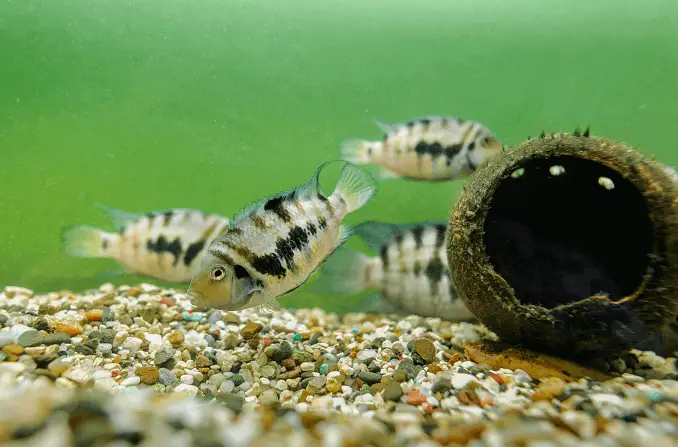 Convict Cichlids naturally inhabit the warm rivers of Central America, ranging from Costa Rica across to Panama.
Convict Cichlids naturally inhabit the warm rivers of Central America, ranging from Costa Rica across to Panama.
In addition to rivers they will be found in streams. They enjoy slow moving waters and are used to sandy and rocky substrates. In the wild they can be found hiding beneath fallen branches and sporadic rock patterns.
Due to their wide natural habitat, they have learned to survive in a wide variety of water conditions and because of this, they are very hardy fish.
With this said, when setting up your aquarium you can use rocks and lots of plants, they also enjoy a slow current. As for substrate you should be looking to use sand, you can also use driftwood.
Convicts are strong swimmers and like to ‘re-arrange’tanks, so make sure you use strong plants (Amazon Swords or Java Ferns) and anchor them.
They have even been known at times to dig out the substrate and create a lot of mess! Because of this, you should make sure to have a strong filtration setup to stop the water getting murky. A good quality hang on back is the bare minimum you should use.
Tank Conditions
As they are used to the warm water of South America, you should make sure to keep the water temperature between 79 and 84°F. Due to their hardiness you don’t need to worry much about pH levels, but try to keep it within 6.6-7.8.
What Size Tank Do Convict Cichlids Need?
If you’re planning to keep a pair of Convicts, the smallest suitably sized tank would be 30 gallons. However due to their aggression, we’d recommend a larger tank of 40 gallons.
If you want to breed them then you should be using at least a 50 gallon tank.
If you’d like to read more on what makes the perfect cichlid tank, read this.
Diet
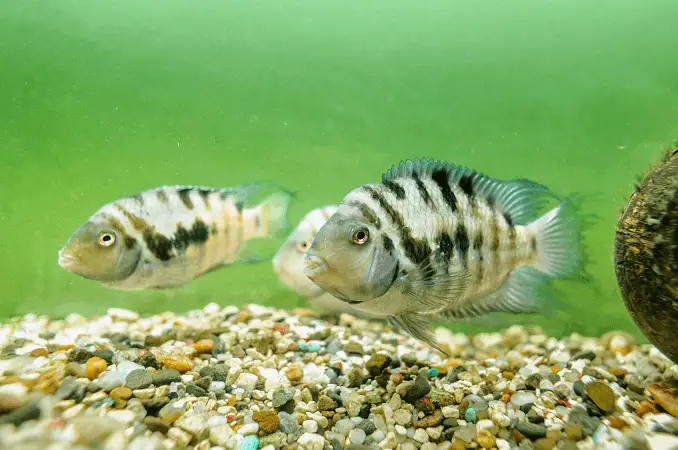
In its natural habitat, in the warm rivers throughout Central America, Convicts will eat small insects, mosquito larvae, and plant debris.
They are a natural omnivore and aren’t fussy eaters; they will eat most things that are placed in the aquarium.
Omnivore means that they will eat both plant and meat matter.
Whilst Cichlids can survive off a wide variety of food, your aim should be to raise healthy Cichlids, so you should ensure their diet fulfills their nutritional requirements.
As always we recommend the core of their diet should be a high quality flake or pellet. You should ensure this pellet is produced specifically for Cichlids.
In addition to their flake/pellet, you can feed them live foods such as Blood Worms, Black Worms, Daphnia and Brine Shrimp. If you can’t find the fresh variety, then the frozen ones will suffice. In addition to the meat, you can feed them blanched vegetables such as:lettuce, broccoli and carrots.
When you’re feeding them, make sure to feed them smaller portions throughout the day instead of a single large portion; this large portion can pollute the tank and destabilize the water conditions. Aim to feed them 2-3 times per day instead.
Compatibility
If you’ve ever seen Convict Cichlids before you could be forgiven for thinking of them as having a timid temperament.
However they are extremely territorial and will be very hostile and aggressive, if fish enter ‘their’ territory. Generally speaking they do not make a good choice for a community tank.
If you’re a beginner then we would recommend you keep Cichlids in their own tank with no other species. This is the easiest way to prevent any issues arising with other fish. However, if you have some experience and are looking to add Convicts to a community tank then there are some rules you need to follow.
First, you should ensure that you don’t keep them with any smaller or less aggressive fish. You should only keep them with larger species that can stand their own ground, for example:
- Green Terror
- Jack Dempsey
- Pictus Catfish
- Giant Danio
- Other South American Cichlids (Jewel and Firemouth).
Keeping Convict Cichlids Together
You can keep Convicts together however you should be prepared for them to breed.
Also you should not keep breeding pairs in a community tank as you’re asking for aggression and trouble. If you read the behavior overview above, you will know they are territorial at the best of times, during spawning periods the aggression gets worse.
With each Convict being different it’s hard to make general statements, but in general you will find a male taking over the whole tank if the aquarium is too small for them; so make sure you use at least a 50 gallon tank.
Breeding
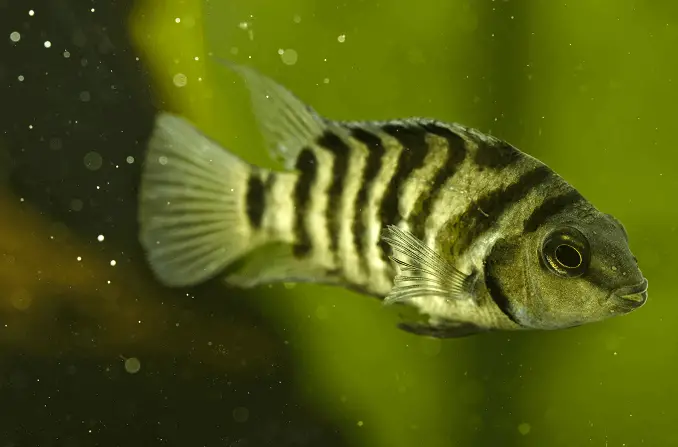 One area that Convicts excel in is breeding; they are incredibly easy to breed and make great parents.
One area that Convicts excel in is breeding; they are incredibly easy to breed and make great parents.
Whilst lots of species won’t breed in home aquariums, Convicts are the exception. Just make sure you have a large enough tank (50 gallons) with a suitable layout and fry will be on their way!
They reach sexual maturity at around 7 months old so they will be ready to breed then. You will obviously need a paired male and female (read the appearance section above for more on this) and they will spawn pretty much all year round.
In the wild females will lay their eggs inside caves or on rocks so you need to emulate this inside your breeder tank as closely as possible. You can use flat stones, or flower pots to create caves; truth be told they aren’t too fussy so just about anything will do.
In terms of water parameters follow the guidance above (in the Habitat and Tank Requirements section) with one exception; heat the water up to 84°F.
Once the male has fertilized the eggs, the female will guard the eggs and the male will guard the perimeter.
After 4 days you can expect the eggs to hatch and you will get around 30 little Convicts! It’s during this stage you will notice what great parents they make as they will find them food and shelter and keep any other fish away from them.
After a further 5 days you should expect them to abandon their yolk sac and start to swim.
As a side note this can be the time where the father can become aggressive to the fry. To stop this you can remove him from the tank and leave the fry with their mother.
Is the Convict Cichlid Right for Your Aquarium?
Hopefully now you know enough to figure out if the Black Convict Cichlid is the right fish for your aquarium.
Their hardy nature, ease of care and vibrant colors make them ideal for a beginner. In addition they are also perfect for beginners looking to get into breeding fish.
Due to their territorial nature it isn’t recommended you place them with other species, instead you should keep them in a separate tank.
Do you keep Convict Cichlids? Let us know your experience with them in the comments section below…

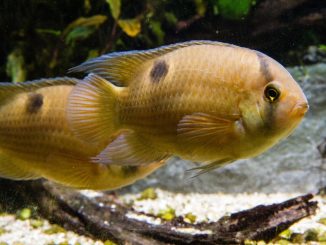
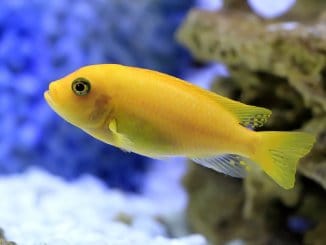
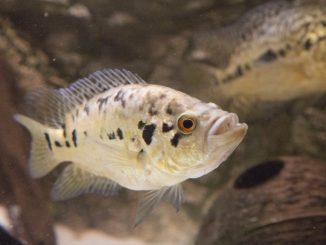
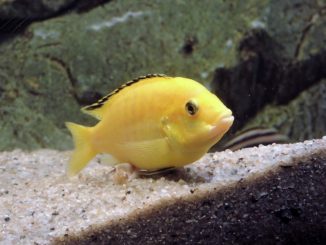
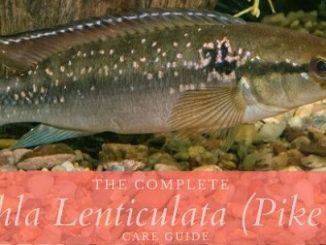
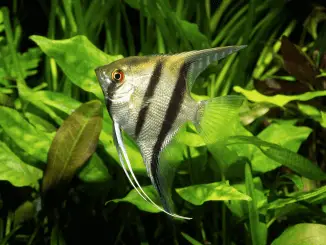
Just picked up a breeding pair of Convicts! I’m excited to watch their breeding behaviors, as they’ve got a 30 gallon tank all to themselves.
Derek, I got 3 on sale at Petsmart over 5 years ago. I now have 17 in a 20 Gallon, and 18 in a 25 Gallon. Don’t be too eager, they don’t die! You will go to fish stores to trade them in, and the owners will say, “No, Breeders!”
I’ve decided to put a single male pink covict cichlid in my big tank with the tougest most aggressive hybrid sunfish pair the male will not tolerate any bullying from the male pink convict.???? HA HA HA HA HA HA HA HA HAAAA
Your going to have a 100 fish with in a year
How long do I leave fry with mom and dad I got about 50 in there now they are about week old starting to swim mom and dad are still protecting them just don’t know how long to leave them
Hi Johnathan, you can remove the dad now because he’ll start to become aggressive, leave the mom in there with them. Thanks, Robert
I thought I had bought four males from my pet store but somehow a female found her way into the tank too. I had a 30 gallon tank, lots of caves and plants, with five Mollies, a Rainbow shark, a juvenile Jack Dempsey and three Kuhi loaches. They got on great for five months with no problem at all. I went away for the weekend and when I came back on Monday morning the Loaches were gone, the Jack Dempsey was dead, two convicts were dead and the Rainbow Shark’s tail fin looked like a floor mop. It was then that I saw the convict fry, knew a female was in the tank and realised the male parent convict had gone to war on all the other fish in the tank and he was winning. My advice if you see convict fry in your tank is to get the male out of there as soon as possible before he takes the whole tank down.
Hello I need help please. convict female/ Jack Dempsy bred.
About a 100 fry, I reduced to 30 now 60 days later mom still ptotecting. Fry are now picking mom to death. Like she is a carrot snack.
Why? I have additional 55 with 30 fry and 2peacocks.
Do I relocate mom to small tank she looks weak
Hi Rain, yes I would definitely remove her to a separate tank if she is being picked on. Thanks, Robert
If I put a pair of [BARTRAMS BASSFISH] 4 blue spotted sunfish, 4 firemouth cichlids in a long long long long long 40 gallon with a single male pink convict WILL that be a great community.
I had a pair of convict cichlids and they easily had more than 100 babies. I had 11 fish tanks setup at 1st and moved the parents to the next tank. They can lay eggs monthly. Mine did. Gave a bunch away. They are cool to watch. Very protective parents. Now my babies are havin babies.?
How long will it take mine to get to sexual maturity they’re about 2.5” at the moment?
3-4 months max before they start breeding
I have 4 breeding pairs in a 30 gal breeder tank and have no problem between them. One pair has been producing 4 to 6 Albinos in each batch
I have 4 breeding pairs about the size of yours. They mature at 8 to 10 months old and should breed at that time.
They are sexually mature at about 7 months old.
Have had convicts for for about 7 years. 5 generation all inbred. Got so bad I start sucking up the fry while doing water changes. Had parrot fish in my 50 gallon and put my convicts with them they got along well. Both semi aggressive parrot fish just bigger.
I did not notice that my pair of Convict Cichlids had even laid eggs. I thought they were preparing to lay eggs. Last night I saw the fry. They are free swimming. That means they are about 4 or 5 days old? Can I move them to a separate take now or should I wait a few days?
Last night I saw the fry. They are free swimming. That means they are about 4 or 5 days old? Can I move them to a separate take now or should I wait a few days?
Can convict cichlid be kept with African cichlid?
My female albino pink one passed her breeding partner should I get another or leave him alone it’s sad.
I have two convict with three baby oscar but the convict are bullying them and they don’t let the oscar swim
Should I remove convicts when cleaning the tank?
So I have a convict and he is just aggressive as can be. Can he live in a tank all on his own . Like I feel bad for him living all alone. Also could I give him a snail friend.
Hello. One of my Convicts has 3-5 red/orange dots on one side of the belly. Long anal fin, a pink tail fin. Is there any way to tell if this is a male or female? Thank you!
Hi. I’ve only found two examples of what my question/comment pertains to, and they were also on forums.
I have a single convict cichlid fry in a 20 gallon tall tank. Clay substrate. Large aquatic fern. Driftwood pile. Resin cave.
I plan to keep this convict by itself in hopes that 1) the convict will bond to me 2) I will see a “nicer” side of the convicts (mainly a heightened aspect of personality through bonding)
With that being said, is this cichlid more likely to be male or female? My fry is about a month old, perhaps less. My fiance bred them so I kept one.
Also, when will I know the gender?
Lastly, can I keep any sort of “bottom feeder” with it? I have ramshorn snails and 2 mystery snails I know I will need to put into a different tank. I’ve wondered about crayfish? It seems as though there isn’t anything, but also limited results for my specific situation.
I have 4 breeding pairs in a 30 gal breeder tank and have no problem between them. One pair has been producing 4 to 6 Albinos in each batch
My convicts just layer eggs on the back of the no fishing sign!
My Convicts just layed eggs on the back of the no fishing sign.
I have a convict in a community tank and saw him or her very friendly with a jaguar,couple of days after they both were being very aggressive to the other fishes when I investigate I saw they had eggs and was protecting it I removed everyone of them into separate tanks convict and jaguar by their self and others in another tank. About 3 to 5 days after the eggs hatched and now I’m just looking to see what they will come out to be
Having raised Convicts(fish-type) years ago, I invested in some juveniles (Fish non-delinquent). I really enjoyed watching their breeding and parenting habits and am hoping to enjoy these as much in due time. P.S. I really enjoyed some of the comments.
Is it ok to have 2 females and 1 male in a 50 gallon tank?
I have 2 breeding pairs of Convicts. One set is great parents and they protect the fry and the other set eat the fry as soon as they begin to hatch. Any ideas on why 1 set behaves one way and the other set breaks the norm and eats the babies?
Hello,
We have been breeding convicts for about a year and a half now. we have not been doing this on purpous. We Started with 2 breeding pair of black convicts that have had multiple sets of babies. some live some die. we then got a set of breeding pink convicts. they too have had sets of babies. i took 3 of my almost adult black babies out of the main tank and put them in a seperate tank for my kid. the two babies killed the 3rd and now are a breeding pair. so they have a set of babies. mind you the parents and grandpartens are all black convicts. the new fish are hald black and half white and some of the whites are marbled. can anyone explain what happened. and just to be clear… the pink convicts i have never bread to the blacks. the blacks are much older then any of the whites.
My male started swimming at the top and making bubbles after the babies hatched. Amonia levels are fine and I don’t see any difference in his scales or eyes. We did a water change and tank cleaning a little over a week before they spawned. Is it possible he’s stressed and needs to be moved to his own tank?
help my fish laid eggs Its been 1 month sense they have seen each other my male and female convict fish so is it possible its baby eggs and also do I have to put the male fish back, also they have very tiny tank the one with the eggs haves those bowls tank and some okay rocks and same for the other also if anyone live in San Diego CA and is willing to come to my house and keep them for free this is my phone number 619-288-0976 please text this fish really deserve something better